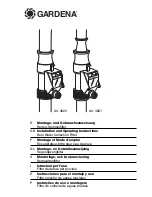
2
INTRODUCTION TO BEAD FILTRATION
EN
WHAT IS THE THEORY BEHIND BEAD FILTER OPERATION?
Bead filters accomplish two goals, one being water polishing (solids capture) and the other being bio filtration. Other filtration systems also
accomplish these goals, but are much larger and more difficult to clean. The advantage of the bead filter is that it provides a home for
beneficial bacteria with high surface area for a large colony per cubic foot and fine particulate straining all within the same vessel. The other
big advantage the bead filters have over other types of filters is that they are much easier to clean. This makes the hobby of KOI or pond
keeping a lot more enjoyable, with less work involved in maintaining a healthy environment for the fish.
HOW DOES A BEAD FILTER PERFORM MECHANICAL FILTRATION?
Mechanical filtration or clarification is the process of removing suspended solids from water. Suspended solids in a recirculating system are
generally small particles of undigested food, bacteria, and algae. These solids tend to reduce the clarifying of water and cause problems in
consuming tremendous amounts of oxygen, also needed by our beloved fish. Bead filters remove solids from water by different mechanisms.
Physical straining is probably the most dominant mechanism of removing larger particles (>50 microns). Finer particles (<20 microns) are
removed at a lower rate by a process called bio absorption. The particles are captured by bacterial bio film on the surface of the bead. Studies
show that bead filters capture 100% of particles >50 microns and 48% of particles in the 5-10 micron range per pass. The more passes the
more solids captured. **Important** in order for the bead filter to perform FINE micron straining it MUST be fully colonized with bacteria.
Depending on the temperature this can take up to 4-6 weeks, at temps. above 60-65 degrees F.
HOW DOES A BEAD FILTER PERFORM BIO FILTRATION?
Bio filtration depends on the establishment of a colony of bacteria on the surface of the beads large enough to convert dissolved toxic
nitrogenous waste to harmless compounds. When the bacteria are given the proper environment, they grow in a thin bio film on the surface
of each bead. Each cubic foot of beads contains about 600,000 beads. This is one of the secrets of the bead filters´ success--high surface area
per cubic foot for a large bacterial colony per cubic foot of filter media. The two most common types of bacteria are, Nitrosamines, which is
responsible for the break down of ammonia in the system. The next is Nitrobacteria, which is responsible for the breakdown of nitrite into
relatively harmless nitrate. **Important** in order for the bead filter to perform Bio filtration the beads must be colonized with a large
enough colony to handle the load of dissolved ammonia presented to it. This may take up to 4-6 weeks at temps. above 60-65 degrees F. Until
the colony has grown large enough, the pond owner MUST be responsible for monitoring the levels of ammonia and nitrites in the pond
water and taking appropriate measures to correct dangerously high levels.
HOW DO YOU SIZE A BEADFILTER?
Unlike the most of the traditional multi-chamber filters we do not only regard pond capacity but also to the (future) fish load. One often
forgets to keep in mind that our koi grow very fast each year and we often buy new fish. In case of a multi-chamber filter this means we need
a lot of extra space to install the filter but in the case of an Xclear Beadfilter the difference in dimensions is not that big. What matters is the
amount of beads. The biggest model can be placed on a surface of 1m² ! So first check the max. fish load for each model that suits your
(future) fish load. For ornamental ponds without koi you can multiply the max. pond content by 2.
WHAT PUMP DO I USE WITH MY FILTER?
As Xclear Beadfilters are pressure vessels, the pump sits in front of the filter, therefore almost any external dry mounted pump with a head
pressure of 6-7 is suitable. Keep the pressure loss in mind regarding the filter and the pipe work. A good rule of thumb is that the pump must
be capable to have a flow of about 40 - 50% of the pond contents per hour with a head pressure of 0,2 – 0,3 bar (2 - 3 meter). With the bypass
system it is also possible to use low pressure pumps which saves a lot of energy!
IS AN XCLEAR BEADFILTER ONLY SUITABLE FOR PONDS?
No, an Xclear Beadfilter is also very suitable for salt- and fresh water aquaria and
is also very suitable for swimming ponds.
BYPASS SYSTEM
Installing the bypass allows the use of more economical pumps. Due to a very compact
bypass-system, the multi-way valve is completely unused during filtering as the water
flows directly into the filter and also leaves the filter in a direct line. This action results
in at least 30% less pressure loss (depending on the type of pump). Thanks to its threaded
coupling the bypass system is easy to install. Connection: 400/500/600; 50mm.
750/900; 63mm.
RETURN
TO POND
INLET
PUMP



































